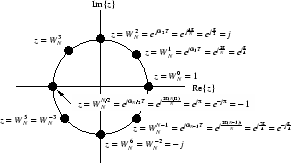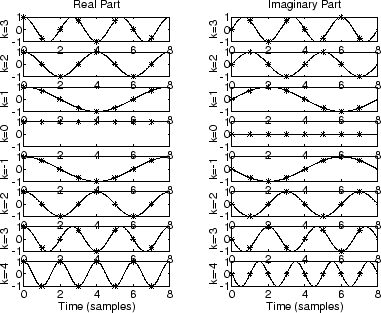NOTE: THIS DOCUMENT IS OBSOLETE, PLEASE CHECK THE NEW VERSION: "Mathematics of the Discrete Fourier Transform (DFT), with Audio Applications --- Second Edition", by Julius O. Smith III, W3K Publishing, 2007, ISBN 978-0-9745607-4-8. - Copyright © 2017-09-28 by Julius O. Smith III - Center for Computer Research in Music and Acoustics (CCRMA), Stanford University
<< Previous page TOC INDEX Next page >>
Orthogonality of Sinusoids
A key property of sinusoids is that they are orthogonal at different frequencies. That is,
This is true whether they are complex or real, and whatever amplitude and phase they may have. All that matters is that the frequencies be different. Note, however, that the sinusoidal durations must be infinity.For length
sampled sinuoidal signal segments, such as used by the DFT, exact orthogonality holds only for the harmonics of the sampling rate divided by
, i.e., only over the frequencies
. These are the only frequencies that have an exact integer number of periods in
samples (depicted in Fig. 7.2 for
).
The complex sinusoids corresponding to the frequencies
are
These sinusoids are generated by theroots of unity in the complex plane:
These are called theroots of unity because each of them satisfies
Theroots of unity are plotted in the complex plane in Fig. 7.1for
. In general, for any
, there will always be a point at
, and the points equally subdivide the unit circle. When
is even, there is a point at
(corresponding to a sinusoid at exactly half the sampling rate), while if
is odd, there is no point at
.
The sampled sinusoids corresponding to the
roots of unity are plotted in Fig. 7.2. These are the sampled sinusoids
used by the DFT. Note that taking successively higher integer powers of the point
on the unit circlegenerates samples of the
th DFT sinusoid, giving
,
. The
th sinusoid generator
is in turn the
th power of the primitive
th root of unity
. The notation
,
, and
are common in the digital signal processing literature.
Note that in Fig. 7.2 the range of
is taken to be
instead of
. This is the most ''physical'' choice since it corresponds with our notion of ''negative frequencies.'' However, we may add any integer multiple of
to
without changing the sinusoid indexed by
. In other words,
refers to the same sinusoid for all integer
.

